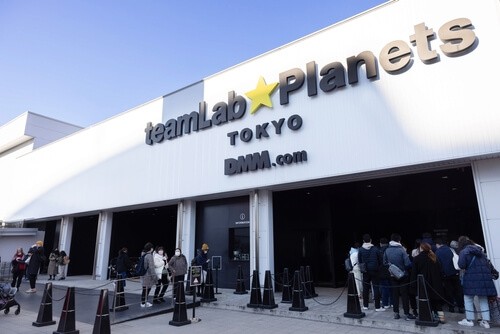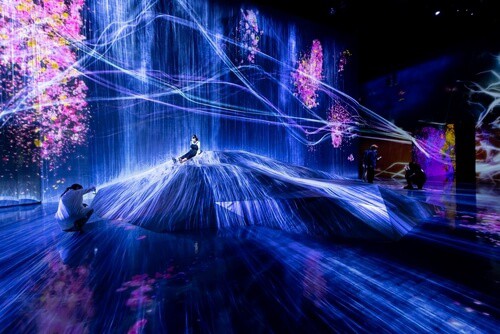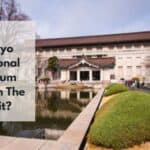Is teamLab Tokyo worth it? Read our comprehensive review to find out everything you need to know before you go. Learn about the museum’s immersive exhibits, interactive artworks, and more. Discover the best time to visit, what to wear, and how to save money on tickets.
teamLab Planets Tokyo is one of the most popular tourist attractions in Japan. It is a digital art museum that features immersive exhibits and interactive artworks. Visitors can explore different worlds, create their own art, and have unique experiences.
But is teamLab Tokyo worth it? In this article, we will take a comprehensive look at the museum and answer all of your questions. We will cover the following:
- What is teamLab Planets Tokyo?
- What are the museum’s exhibits like?
- Is teamLab Tokyo worth the price of admission?
- When is the best time to visit teamLab Tokyo?
- What should I wear to teamLab Tokyo?
- How can I save money on tickets to teamLab Tokyo?
By the end of this article, you will have all the information you need to decide whether or not teamLab Tokyo is worth a visit.
Page Contents
Is teamLab Tokyo Worth It?

TeamLab Tokyo is undeniably worth the visit for those seeking a unique fusion of art and technology. Its immersive installations, interactivity, and sensory engagement create an unforgettable experience.
However, the relatively high ticket prices and occasional crowds might deter budget-conscious travelers or those seeking a quieter art experience.
Nevertheless, the opportunity to step into otherworldly realms, interact with digital art, and witness the ever-changing seasonal exhibits makes TeamLab Tokyo a must-visit for art enthusiasts and tech aficionados looking to be transported to a mesmerizing digital wonderland.

- Related: Is Tokyo National Museum Worth It?
What is TeamLab Tokyo?
TeamLab Tokyo is an immersive digital art museum located in the heart of Japan’s capital city. It’s the brainchild of TeamLab, a collaborative group of artists, engineers, and programmers who specialize in creating interactive, immersive installations that push the boundaries of traditional art forms.
The museum is designed to engage all your senses, blurring the lines between the physical and digital worlds.

The Experience at teamLab Tokyo
TeamLab Tokyo offers a unique and enchanting experience that’s unlike any other art gallery or museum. Here are some of the key elements that make it worth considering:
- Immersive Art Installations:
- Crystal Universe: One of the standout installations at TeamLab Tokyo, Crystal Universe, is a breathtaking display of thousands of LED lights suspended in a dark room. These lights respond to human movement, creating a dynamic and ever-changing visual spectacle that makes you feel like you’re floating through a galaxy of stars.
- Flower Forest: Imagine walking through a forest of flowers that respond to your presence. The Flower Forest at TeamLab Tokyo is an immersive installation where digital flowers bloom and wither as you move through the space, creating a mesmerizing and interactive experience.
- Universe of Water Particles: This installation simulates the flow of water particles, allowing you to manipulate and redirect them simply by touching the surface. As you interact with the water, ripples and waves form, creating beautiful and calming patterns.
- Interactive Art:
- Sketch Aquarium: A favorite among children and adults alike, Sketch Aquarium lets you draw your own aquatic creatures, which are then scanned and projected onto a virtual aquarium. You can watch your creations swim alongside those of other visitors, blurring the line between the physical and digital worlds.
- Light Ball Orchestra: In this interactive exhibit, you can roll large light-up balls around a dark room. Each ball emits different musical notes and colors as it moves, allowing you to create your own unique symphony of light and sound.
- Sensory Stimulation:
- Soundscapes: TeamLab Tokyo pays close attention to audio as well. Each installation is accompanied by a carefully crafted soundtrack that enhances the overall experience. You’ll hear everything from tranquil nature sounds to futuristic electronic compositions, adding an auditory layer to the visual spectacle
- Scents: In some installations, TeamLab incorporates scents that complement the visuals and create a multisensory experience. For example, a flower garden exhibit might release the scent of flowers as you explore, further immersing you in the environment.
- Changing Seasons:
- TeamLab Tokyo embraces the concept of seasonal art. The installations change with the seasons, aligning with Japanese cultural traditions and natural changes in the environment. This means that if you visit during different times of the year, you’ll encounter entirely new art experiences, ensuring that TeamLab Tokyo remains a fresh and exciting destination for repeat visits.
In summary, TeamLab Tokyo offers a multi-faceted experience that engages all your senses. It combines stunning visual displays with interactive elements, soundscapes, and even scents, creating a truly immersive environment that blurs the boundaries between the physical and digital worlds.
Whether you’re fascinated by cutting-edge technology, a lover of art, or simply seeking a unique and captivating adventure, TeamLab Tokyo promises an experience that is as memorable as it is enchanting.
- Related: Is Legoland Tokyo Worth It?
Which teamLab is better in Tokyo?
Whether teamLab Borderless or teamLab Planets is better in Tokyo depends on your personal preferences.
teamLab Borderless is a larger museum with a wider variety of artworks, including some of teamLab’s most iconic pieces, such as Forest of Resonating Lamps and Waterfall of Light. It is also more popular, so it can be more crowded.
teamLab Planets is a smaller museum with a more focused experience. It focuses on immersive artworks that allow visitors to interact with the art and create their own unique experiences. It is also less crowded, making it a good option for visitors who want a more relaxed experience.
Here is a table comparing the two museums:
| Feature | teamLab Borderless | teamLab Planets |
| Size | Larger | Smaller |
| Variety of artworks | Wider | More focused on immersive artworks |
| Popularity | More popular | Less popular |
| Crowdedness | More crowded | Less crowded |
Which museum is better?
If you are looking for a museum with a wide variety of artworks and don’t mind the crowds, then teamLab Borderless is the better choice. If you are looking for a more immersive experience and don’t mind a smaller museum, then teamLab Planets is the better choice.
Ultimately, the best way to decide which museum is right for you is to visit both and see which one you enjoy more.
Personal recommendation
I personally prefer teamLab Planets. I find the immersive artworks to be more engaging and thought-provoking. I also appreciate that the museum is less crowded, which allows me to have a more relaxed and personal experience.
- Related: Is Tokyo Joypolis Worth It?
Cons Of temLabs Tokyo
While TeamLab Tokyo offers a captivating experience, there are some aspects to consider before making the trip:
- Ticket Prices: Admission to TeamLab Tokyo can be relatively expensive, especially for families or budget-conscious travelers. However, many visitors argue that the experience justifies the cost.
- Crowds: TeamLab Tokyo is extremely popular, and it can get crowded, especially on weekends and holidays. This can affect the quality of your visit as you may have to wait in line for certain installations.
- Time Constraints: Given the popularity of the museum, there may be time constraints on how long you can spend in each installation. This can limit your ability to fully immerse yourself in the art.
Conclusion
So, is TeamLab Tokyo worth it? The answer largely depends on your interests, budget, and expectations.
If you’re an art enthusiast, a tech aficionado, or simply looking for a unique and memorable experience, then TeamLab Tokyo is undoubtedly worth a visit. Its immersive art installations, interactivity, and ability to transport you to otherworldly realms make it a one-of-a-kind destination.
However, if you’re on a tight budget or prefer a quieter, more contemplative art experience, you might want to weigh the costs and crowds against the potential benefits.
In the end, TeamLab Tokyo has earned its reputation as a must-visit destination for those seeking an unforgettable journey through the intersection of art and technology.
It’s a testament to the boundless creativity of the human spirit and a reminder that art, in all its forms, has the power to inspire, transform, and transport us to new dimensions of wonder.
- Related: Is Tokyo Dome Worth It?
How long to spend at Teamlabs Tokyo?
You can spend anywhere from 2 to 3 hours at teamLab Planets Tokyo. This will give you enough time to see all of the exhibits and take some photos. If you want to take your time and really enjoy the experience, you could spend up to 4 hours.
Here are some tips for maximizing your time at teamLab Planets Tokyo:
- Arrive early in the morning or late in the evening to avoid the crowds.
- Wear comfortable shoes, as you will be doing a lot of walking.
- Take your time and explore each exhibit.
- Don’t be afraid to interact with the art.
- Take lots of photos and videos!
Here is a suggested itinerary for a 2-hour visit to teamLab Planets Tokyo:
- 10:00 AM: Arrive at the museum and take off your shoes.
- 10:15 AM: Start at the Infinity Mirror Room – Water Particles on the Body I exhibit.
- 10:30 AM: Continue to the Body Immersive Space – Crystal Universe exhibit.
- 10:45 AM: Take a break and have a drink at the cafe.
- 11:00 AM: Visit the Infinity Mirror Room – Forest of Resonating Lamps exhibit.
- 11:15 AM: Explore the Floating Forest of Lamps exhibit.
- 11:30 AM: Visit the Infinity Mirror Room – Borderless exhibit.
- 11:45 AM: Exit the museum.
Of course, you can customize this itinerary to fit your interests and time constraints. For example, if you are interested in photography, you may want to spend more time in the Infinity Mirror Rooms. Or, if you are traveling with children, you may want to spend more time in the interactive exhibits.
- Related: Is Tokyo DisneySea Worth It?
What is the best time to go to teamLab Tokyo?
The best time to go to teamLab Tokyo is during the week, early in the morning or late in the evening. The museum is busiest on weekends and during the holidays, so it is best to avoid those times if you want to avoid the crowds.
Here is a more detailed breakdown of the best times to go to teamLab Tokyo:
- Weekdays: The museum is generally less crowded on weekdays, especially early in the morning and late in the evening.
- Weekends: The museum is busiest on weekends, especially during the day.
- Holidays: The museum is also busiest on holidays, so it is best to avoid those times if possible.
- Early morning: The museum opens at 10:00 AM, but it is usually not crowded until after lunch. If you want to avoid the crowds, arrive early in the morning, as soon as the museum opens.
- Late evening: The museum closes at 8:00 PM, but it is usually not crowded in the late evening. If you want to avoid the crowds, visit the museum in the late evening, just before closing time.
If you are flexible with your schedule, the best time to go to teamLab Tokyo is during the week, early in the morning or late in the evening.
However, even if you can only visit on a weekend, you can still have a good experience by arriving early in the morning or late in the evening.
Here are some additional tips for avoiding the crowds at teamLab Tokyo:
- Purchase your tickets in advance. This will save you time and avoid the long lines at the ticket counter.
- Arrive early or late. As mentioned above, the museum is busiest during the day. If you can, arrive early in the morning or late in the evening to avoid the crowds.
- Go during the off-season. If you are visiting Japan during the off-season (winter), the museum will be less crowded.
- Visit on a weekday. As mentioned above, the museum is generally less crowded on weekdays
What to wear to Team Labs Tokyo?
Here are some tips on what to wear to teamLab Planets Tokyo:
- Comfortable shoes. You will be doing a lot of walking, so it is important to wear comfortable shoes. Sneakers or slip-ons are a good option.
- Loose-fitting clothing. You will need to remove your shoes and socks at the entrance, so it is best to wear loose-fitting clothing that is easy to move around in.
- Shorts or pants that can be rolled up. Some of the exhibits feature water features, so it is a good idea to wear shorts or pants that can be rolled up.
- A towel. The museum provides towels, but it is a good idea to bring your own towel to dry off after visiting the water features.
- A hat. The museum can be quite bright, so it is a good idea to wear a hat to protect yourself from the sun.
Here are some additional tips:
- Avoid wearing skirts or dresses. Some of the exhibits feature mirrors, so it is best to avoid wearing skirts or dresses to avoid flashing your underwear.
- Avoid wearing white clothes. The art at teamLab Planets Tokyo is often projected onto the walls and floors, so wearing white clothes can make you look like a ghost in some of the exhibits.
- Avoid wearing jewelry. Some of the exhibits feature magnets, so it is best to avoid wearing jewelry to avoid losing it.
Overall, the best thing to wear to teamLab Planets Tokyo is comfortable, loose-fitting clothing that can be easily moved around in. You should also avoid wearing skirts or dresses, white clothes, and jewelry.
- Related: Is Tokyo Disneyland Worth It?
Can you wear socks in Teamlab Tokyo?
No, you cannot wear socks in teamLab Planets Tokyo. All visitors are required to remove their shoes and socks before entering the museum.
This is because some of the exhibits feature water features, and the museum wants to keep the exhibits clean and sanitary.
The museum provides lockers where you can store your shoes and socks. There are also towels available for visitors to use after visiting the water features.
If you have any concerns about walking barefoot, the museum staff can provide you with a pair of disposable slippers.
Can you bring cameras into Teamlab Tokyo?
Yes, you can bring cameras into teamLab Planets Tokyo. However, there are some restrictions:
- You cannot bring tripods, monopods, or selfie sticks into the museum.
- You cannot use flash photography in the museum.
- You are asked to be respectful of other visitors and to avoid taking photos that obstruct their view.
The museum provides lockers where you can store your tripods, monopods, and selfie sticks.
Here are some tips for taking photos at teamLab Planets Tokyo:
- Use a manual mode on your camera. This will give you more control over your settings and allow you to take better photos.
- Use a low ISO setting. This will help to reduce noise in your photos.
- Use a wide aperture. This will allow you to blur the background and focus on your subject.
- Experiment with different angles and perspectives. There are many different ways to take interesting photos at teamLab Planets Tokyo.
- Be patient. It may take some time to get the perfect shot.
Can you be late for Teamlab Tokyo?
Yes, you can be late for teamLab Planets Tokyo. However, you must arrive within one hour of your scheduled entry time. If you arrive after one hour, your ticket will be cancelled.
If you are running late, you should contact the museum staff as soon as possible. They will be able to help you get into the museum as soon as possible.
If you do arrive late, don’t worry. The museum is still a great experience, even if you don’t have as much time as you would like. Just take your time and enjoy the art.
How big is teamLab Tokyo?
teamLab Planets Tokyo is a relatively small museum, with a total floor space of approximately 10,000 square meters. However, the museum is packed with immersive artworks that allow visitors to interact with the art and create their own unique experiences.
The museum is divided into four main areas:
- Body Immersive Space – Crystal Universe: This area features a large, mirrored room filled with crystals. Visitors can walk barefoot on the crystals and interact with the light and sound effects.
- Infinity Mirror Room – Water Particles on the Body I: This area features a small, mirrored room filled with water particles. Visitors can stand in the middle of the room and watch as the water particles dance around them.
- Floating Forest of Lamps: This area features a large, dark room filled with floating lamps. Visitors can walk through the room and interact with the lamps.
- Infinity Mirror Room – Borderless: This area features a large, mirrored room filled with plants and flowers. Visitors can walk through the room and interact with the plants and flowers.
In addition to these four main areas, the museum also has a number of smaller exhibits and installations.
Overall, teamLab Planets Tokyo is a relatively small museum, but it is packed with immersive artworks that provide a unique and memorable experience for visitors.
What’s the ticket price to enter TeamLab Tokyo?
The ticket price to enter teamLab Planets Tokyo varies depending on the age of the visitor:
- Adults (18 years and above): 3,800 JPY
- Junior high school and high school students: 2,300 JPY
- Children (4-12 years old): 1,300 JPY
- Under 3 years old: Free
There is also a discount available for groups of 20 or more people.
Tickets can be purchased online or at the museum. However, it is recommended to purchase tickets online in advance, as the museum can be very busy.
How can you save money on tickets to teamLab Tokyo?
Here are some tips on how to save money on tickets to teamLab Tokyo:
- Purchase your tickets online in advance. This will save you time and avoid the long lines at the ticket counter.
- Look for discounts. There are a number of discounts available for groups, students, and seniors.
- Visit during the off-season. The museum is less crowded during the off-season (winter).
- Consider purchasing a combination ticket with teamLab Borderless. This will save you money on admission to both museums.
Here are some specific discounts that are available:
- Group discount: Groups of 20 or more people can save 10% on tickets.
- Student discount: Students can save 10% on tickets with a valid student ID.
- Senior discount: Seniors can save 10% on tickets with a valid senior citizen ID.
- Combination ticket with teamLab Borderless: You can save money by purchasing a combination ticket that includes admission to both teamLab Planets Tokyo and teamLab Borderless
My writing focuses on the various aspects of Japanese lifestyle, from traditional tea ceremonies and flower arrangement to modern fashion trends and pop culture. Through my articles, I aim to share my passion for Japan and provide readers with a glimpse into the rich and diverse world of Japanese culture.
I believe that the key to understanding Japanese lifestyle is to appreciate the balance between tradition and innovation. While Japan has a rich cultural heritage that dates back centuries, it is also a country that is constantly evolving and embracing new ideas and technologies.
Whether you’re interested in learning about the latest fashion trends in Tokyo, or want to explore the ancient art of calligraphy, my writing will take you on a journey through the many facets of Japanese lifestyle. So join me as we explore the beauty and complexity of this fascinating culture together!





